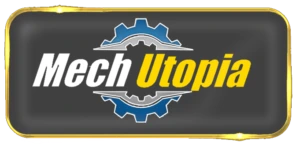Every machinist manual or CNC machinist does not matter and understands that finishing a machining job successfully mostly depends on a work-holding strategy. In other words, you can select the correct cutting tools, feeds, and speeds, however, if your workholding strategy is wrong then you have a serious problem finishing the machining task.
If you need more information about machining please check this blog Introduction to CNC Machining.
Think like this; in the middle of a job you cannot undo any screws, and you cannot dislodge a vise one, otherwise, your machined part would move easily, and at that time believe me, you will have serious problems. So in this article, we will deep dive into workholding and discuss workpiece (work stock) holding methods, devices, and tips to protect you from problematic situations. Also, we will look at some famous brands’ life-easing solutions.
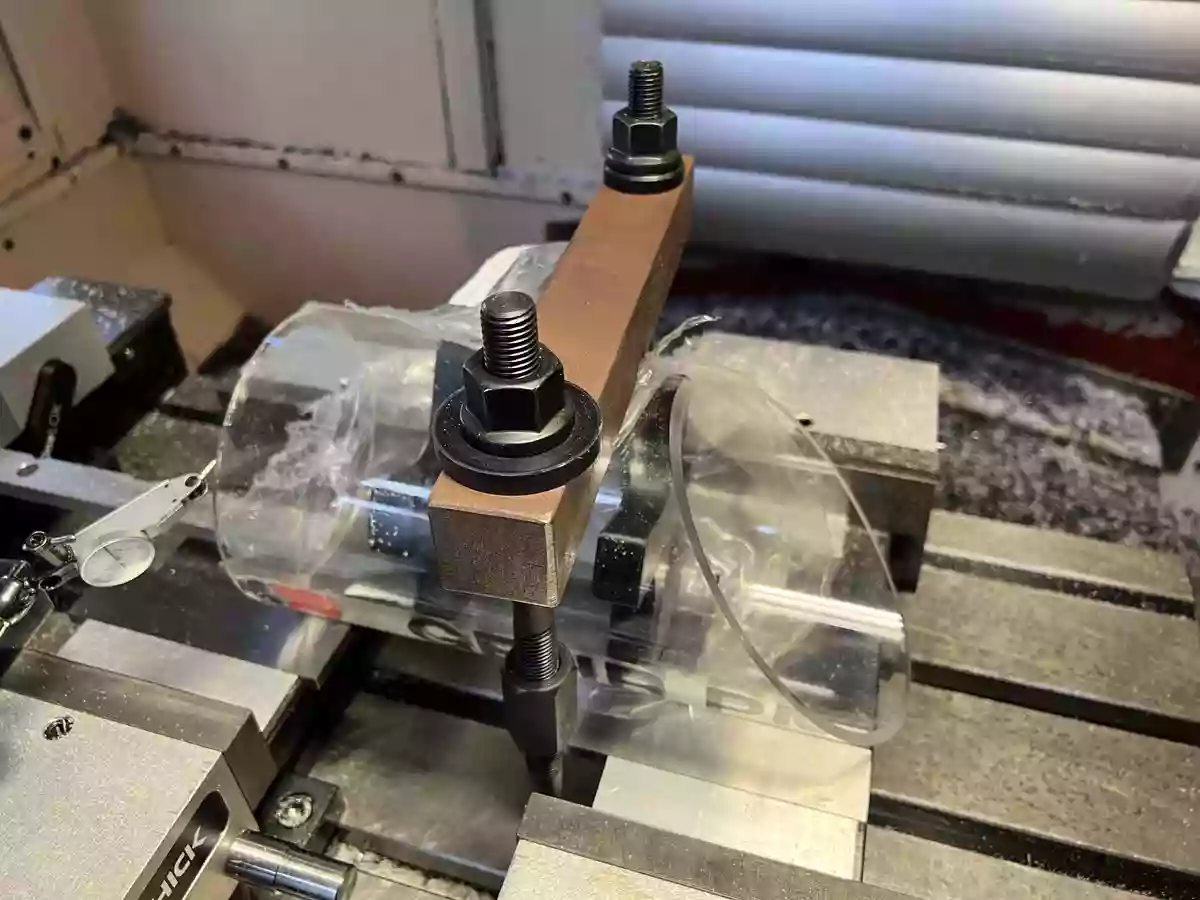
These are the methods and devices used to secure a workpiece firmly in place during a machining operation. The choice of workholding solution can significantly impact the efficiency, precision, and safety of the CNC machining process. From traditional vises and clamps to more advanced fixture plates and soft jaws, the range of workholding solutions is vast and varied, each with unique advantages and applications.
This article highlights CNC workholding methods, solutions, techniques and their significance, various types, and factors for selection to meet machining requirements. Understanding these aspects can help optimize your CNC machining process, ensuring high-quality outcomes while minimizing potential risks.
The Importance of a Strong CNC Workholding Setup
Like I said before strong workholding is key to achieving the machining task. The role of workholding in CNC machining cannot be overstated. It serves as the vital link between the machine tool and the workpiece, forming the backbone of any successful machining operation. Workholding devices transform cutting stress directly to your CNC machine`s spindle and table. A strong workholding setup is essential for several reasons.
Firstly, it maintains the machining process’s rigidity and stability. Holding the workpiece firmly in place prevents any unwanted movement that could lead to inaccuracies or inconsistencies in the final product. Precision and repeatability are crucial in CNC machining, making it particularly important.
Secondly, a robust workholding setup contributes to the efficiency of the machining process. It allows for faster machining speeds and more aggressive cutting parameters, thereby reducing cycle times and increasing productivity.
Thirdly, workholding plays a vital role in maintaining the safety of the machining operation. A secure workholding setup prevents the workpiece from becoming dislodged during machining, which could potentially cause damage to the machine tool or injury to the operator.
Lastly, the right workholding solution can enhance the versatility of the CNC machine, enabling it to handle a wider variety of workpieces and machining operations. Flexibility is advantageous in modern manufacturing, where quick adaptation to various tasks is valued.
Different Types of CNC Workholding Methods
Vise
A vise is a widely used and versatile work-holding device in CNC machining. It consists of two jaws, one fixed and one movable, that clamp the workpiece in place. The strength of a vise lies in its simplicity and reliability. It provides a secure grip on the workpiece, ensuring stability during the machining process.
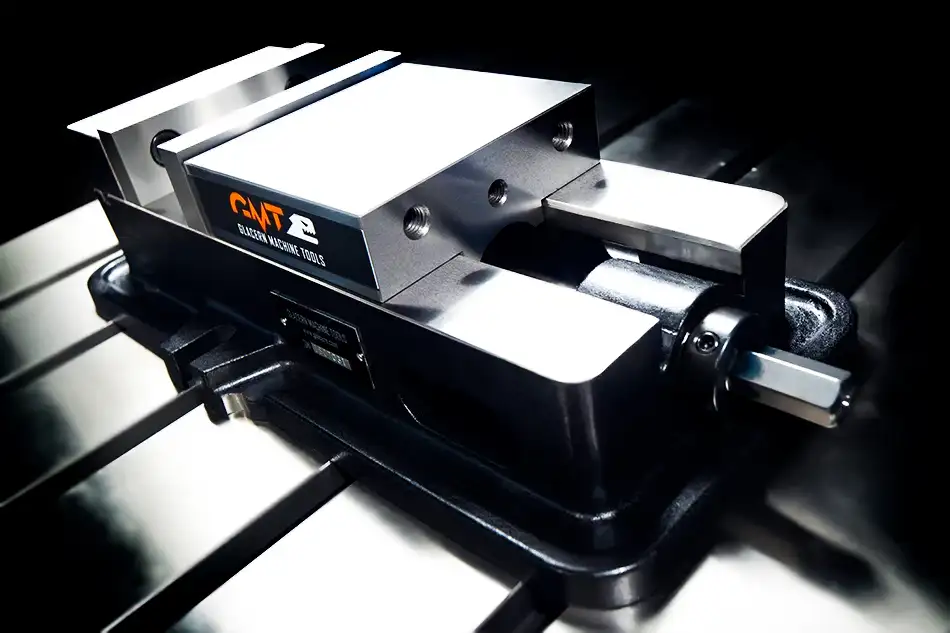
A vise is particularly effective for holding workpieces with flat, parallel sides. However, very high parts can be problematic with holding a vise due to the moment that occurs while machining. Part or vise can be moved.
For instance, very thin parts may warp when tightened in a vise, and the vise can only open so far to accommodate larger parts. Despite these limitations, when set up correctly, a vise offers excellent repeatability and accuracy, making it a staple in many CNC machining operations.
Fractal Vises can be used in very complex irregular shapes easily and repetitively. Check the video below to see how you can hold any part with no extra effort.
Soft Jaws
Soft jaws are a specialized type of workholding method designed to hold parts with irregular shapes or non-parallel sides securely. Vices are commonly made from softer materials like aluminum and shaped to fit the specific profile of the workpiece.
This allows the workpiece to be held securely in a vise, even if it’s round or has non-parallel sides. Soft jaws are quick and easy to machine, making them a cost-effective solution for low to medium-volume production. From my experience, I have found myself re-machining the soft jaws again and again.
Because Soft jaws can wear and change shape under the part-squeezing power of wise.When you repeat the holding process again and again soft jaws can wear very easily. So it can negatively affect the stock`s initial position and can cause wrongly machined geometry on the part.
Step Clamps
Step clamps, also known as toe clamps, are a common workholding method for manual milling. They utilize the T-slots on a machine’s table to provide a firm hold on the workpiece. Step clamps are adaptable to a variety of parts, as long as there’s a flat surface to clamp on.
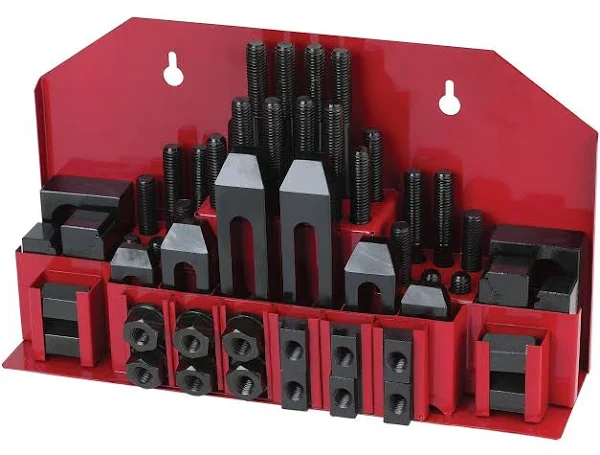
However, they can be time-consuming to set up and are not as repeatable as other workholding fixtures. Once the clamp is loosened, it no longer stays in the same location, requiring reconfiguration for the next part. Despite these drawbacks, step clamps are effective for holding large plates and clamping down fixture plates.
Fixture Plates
Fixture plates, also known as tooling plates, offer a high degree of repeatability and versatility in CNC workholding. They are typically made of aluminum or steel and feature a grid of holes for dowel pins and bolts. The dowel pin holes help locate the fixture or part on the plate, while the threaded holes are used for bolting down the fixture or part.
Fixture plates can be used in several ways, such as designing bolting holes into the part or creating a custom fixture that holds the part and is then bolted to the fixture plate. This workholding method allows access to multiple sides of the part, enabling the machining of complex geometries and surfaces.
Toggle Clamps
Toggle clamps are a type of workholding device that uses a pivoting mechanism, or toggle, to apply clamping force. They are known for their quick action and secure hold, making them ideal for applications that require frequent loading and unloading of workpieces.
C-Clamps
C-clamps, also known as G-clamps, are a type of clamp device typically used to hold a workpiece for various applications, including woodworking, metalworking, and in this context, CNC machining. They are called C-clamps due to their C-shaped frame, but when the screw is included, they have a shape more like a G, hence the name G-clamp. They are not capable to hold aggressive machining jobs. It is generally used to fix the high workpiece to a right-angle plate for light machining operations like drilling.
Tombstones
Tombstones, also known as tooling towers or fixture towers, are a type of workholding device commonly used in CNC milling operations, particularly in horizontal machining centers. Tombstones are a versatile and efficient workholding solution for CNC milling, offering the ability to machine multiple parts or multiple sides of a part in a single setup.
Angle Plates
Angle plates are workholding devices used in milling processes, particularly when a workpiece needs to be held at a precise right angle to the table. Made from high-grade cast iron or steel, they have two flat, perpendicular working surfaces.
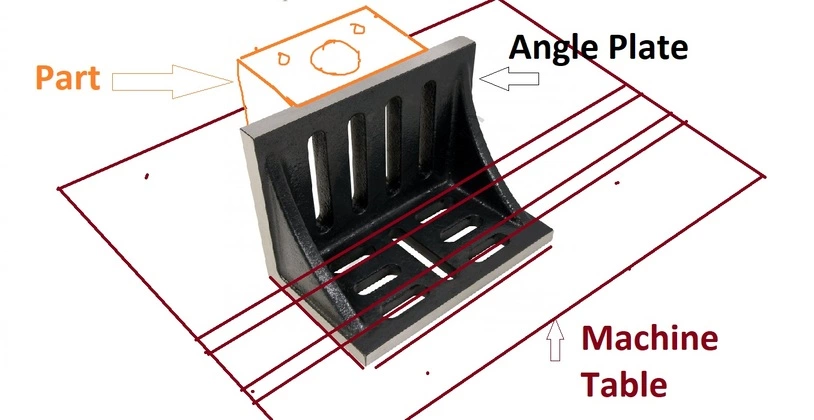
These surfaces have holes or slots for attaching the workpiece or other fixtures. In CNC machining, angle plates are often used with other workholding devices like vises or clamps, especially for machining parts that are large or awkwardly shaped. They offer versatility and precision, making them a key tool in many CNC operations.
Magnetic Tables and Chucks
Magnetic tables, or magnetic chucks, are workholding devices used in CNC machining. They use magnetic force to securely hold ferromagnetic materials like iron or steel during machining. The magnet, when activated, attracts the workpiece and holds it firmly. A larger part contact surface between magnetic table means more stable, stronger material holding.
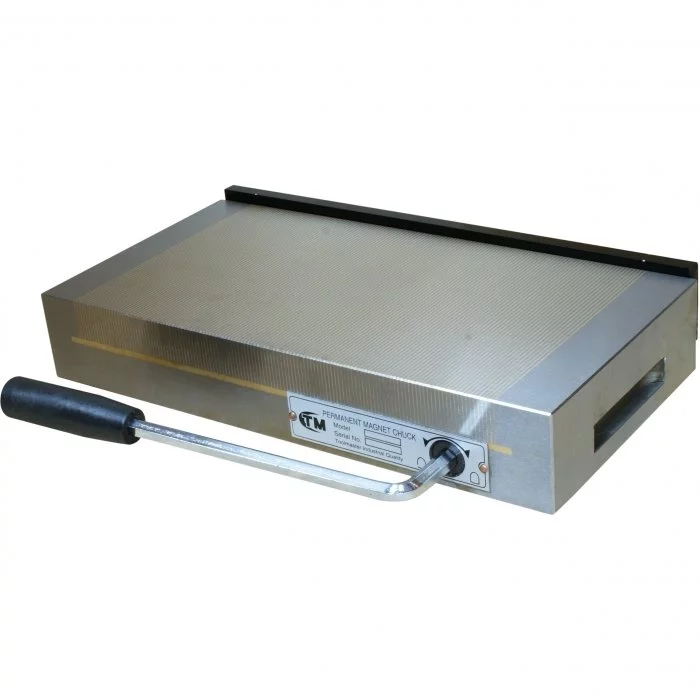
This allows for stability during machining and unobstructed access to the workpiece, making magnetic tables useful for operations like surface grinding or milling. However, they can only be used with iron and steel-like (ferromagnetic) materials. I used often magnetic tables with horizontal boring machines (bohrwerk), which makes it easier to hold large materials vertically with a vertical magnetic table. Also, it can be used with VMC.
Dovetail Fixtures
Dovetail fixtures are often used in 5-Axis CNC machinery. One of the reasons for usage is the robust holding capabilities of these holders. They include a little vise on them, but because to undercut dovetail shape machined to the bottom of the workpiece guarantees a rigid part-holding experience.
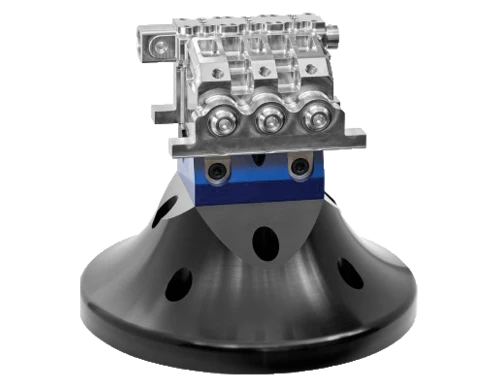
Vacuum Tables
Vacuum tables in CNC machining use vacuum force to secure the workpiece. I have found from my experience that, plastic materials can be machined very well with this workholding method. Generally, they are used by router workshops because they can suck large plastic and wood sheets easily with a vacuum. The table, connected to a vacuum pump, pulls the workpiece down, holding it in place without physical clamps.
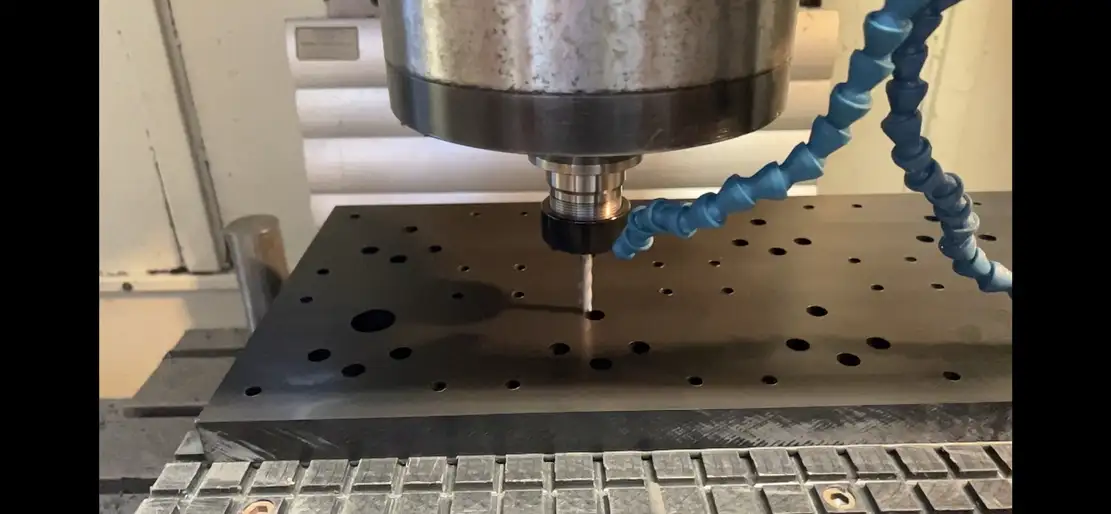
This is ideal for delicate or intricate workpieces, but less effective for porous materials or irregular shapes. Vacuum tables provide unobstructed access to the workpiece, making them useful for certain CNC applications. You must be sure your workpiece is enough large to hold on a vacuum table, with small contact faces parts can be moved easily.
Another thing to watch with this method is you must watch the vacuum leaks and ensure there are no leaks. Otherwise, it can leave the part easily.
Square Chucks
Square Chucks are very easy to hold on a vertical machining center. With this chuck, you can easily hold round parts which are machined on the lathe for second milling operations.
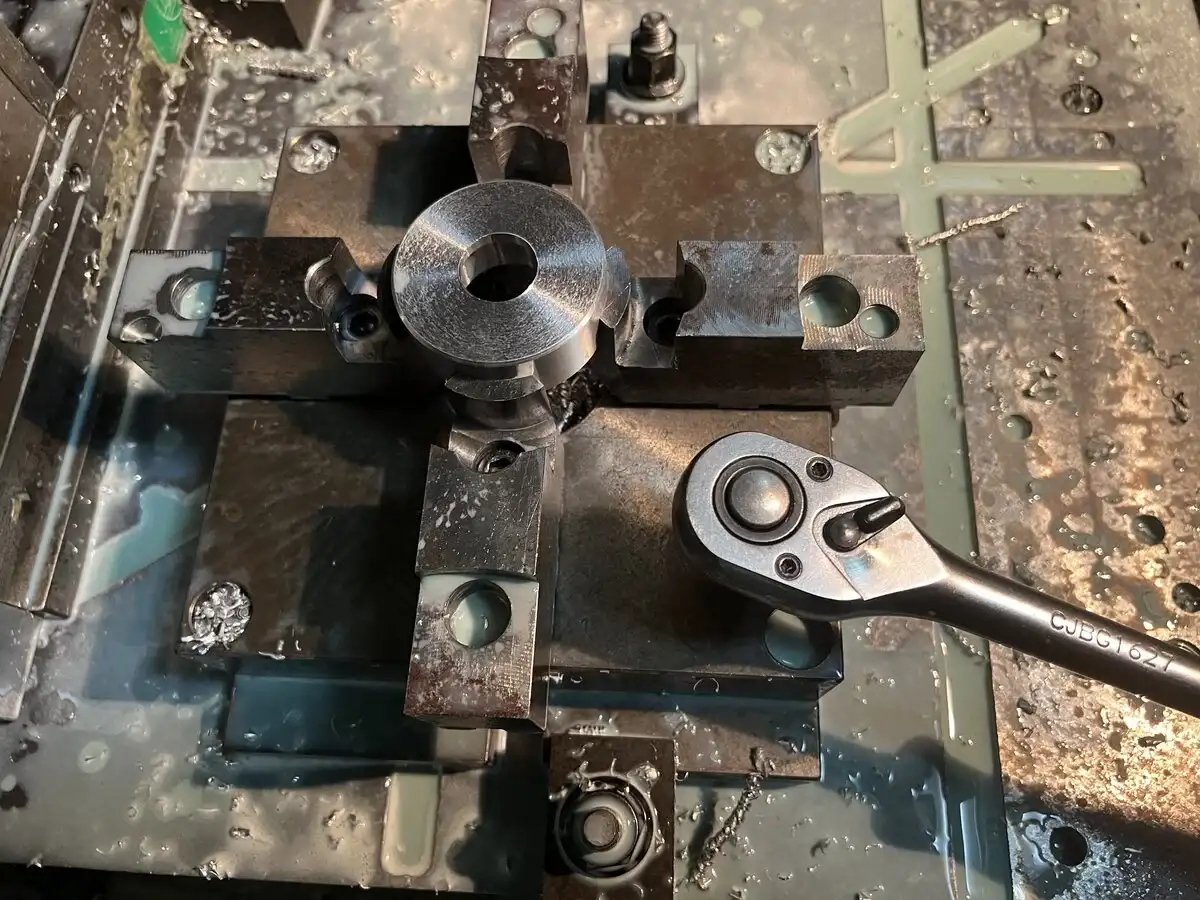
Custom Jigs and Fixtures
This kind of workholding technique will be the most flexible option for you. Because every machinist often requires to mix more than one holding method. For example, in my workplace, I machined a special Fixture plate and hold it with a vise. In the below picture, you can see a custom workholding jig which is a mixture of the vise, and fixture plate.
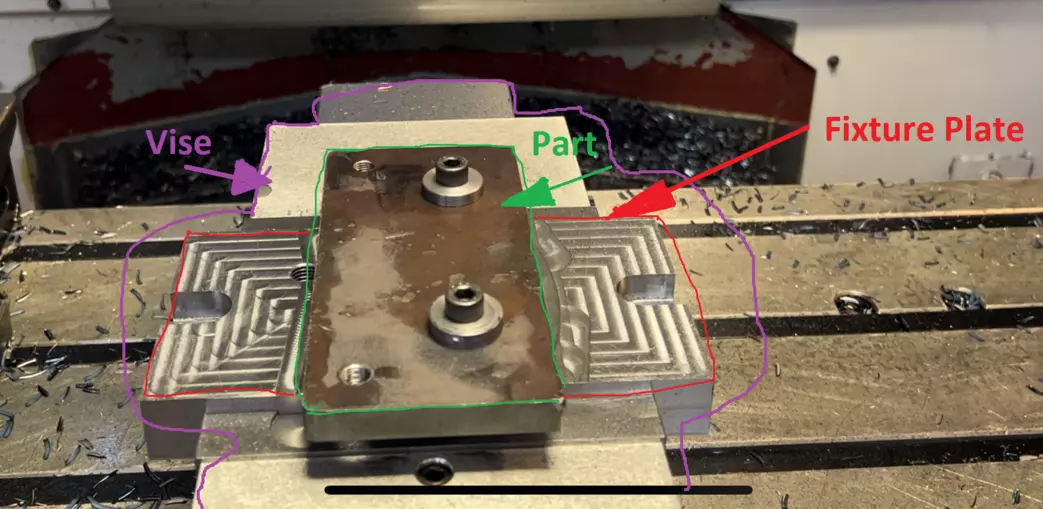
Considerations When Choosing a Workholding Device
Selecting the correct workholding device can greatly affect the success of a CNC machining operation. This is one of the critical steps in creating a successful machining strategy. You must think about several factors before finalizing your selection. One of them is the workpiece geometry.
The shape, size, and complexity of the workpiece are important factors in determining the most suitable workholding device. For instance, a vise is ideal for holding workpieces with flat, parallel sides, while soft jaws are better suited for irregular shapes or non-parallel sides.
Just initially holding a part with step clamps with screws and nuts can be easier rather than machining a new soft jig. In my experience I found myself solving complex machining problems just by holding it with a step block, screws, and nuts.
The below list shows considerations that can affect workholding selection.
- Machining Operations: The type of machining operation being performed also influences the choice of workholding. Some devices offer better stability for heavy milling, while others may be more suitable for precision drilling or tapping. For example; machine features on a part like through holes and exploding pockets require the lift part from the machine`s table. So you can plunge deeper to clean the bottom of the hole and pocket.
- Material Type: The material of the workpiece can affect the choice of workholding device. Harder materials may require more robust clamping to resist the forces of machining, while softer materials(aluminum, brass etc.) may need gentler clamping to avoid deformation. You can check this post if you need more information, CNC Machining Materials
- Production Volume: The volume of parts to be produced is another important consideration. For high-volume production, a workholding device that allows for quick and easy loading and unloading (like toggle clamps)of parts can significantly increase efficiency. On the other hand, when it comes to low-volume or one-off production, flexible solutions can be better for efficiency.
- Accuracy and Repeatability: The level of precision required in the final part can influence the choice of workholding. Some devices offer higher repeatability and accuracy than others, making them more suitable for precision machining operations. Vises or custom fixtures are good examples of holding tools.
- Cost: The cost of the workholding device, including the initial investment and ongoing maintenance costs, should also be considered. While some devices may have a higher upfront cost, they may offer greater efficiency and durability, resulting in lower long-term costs.
- Safety: Safety should always be a primary factor at every stage. The workholding device should securely hold the workpiece to prevent any movement during machining, which could lead to damage to the machine or injury to the operator.
Selecting the right workholding device is a complex decision that demands thorough consideration of multiple factors. The right choice can enhance the efficiency, accuracy, and safety of the CNC machining process, leading to superior outcomes.
The Consequences of Poor Workholding Setups
A poor workholding setup in CNC machining can result in numerous issues and risks. These can cause significant harm to the machine, operator, and workpiece.
- Quality Issues: One of the most immediate consequences of a poor workholding setup is a decline in the quality of the machined parts. If the workpiece isn’t held securely, it can move during machining, leading to inaccuracies and inconsistencies in the final product. This can result in parts that are out of tolerance, which can cause assembly issues or even product failure in severe cases.
- Efficiency Loss: An inadequate workholding setup can also lead to a loss of efficiency. If the workpiece isn’t held securely, it may require frequent adjustments during machining, leading to increased downtime. Additionally, if the workpiece moves during machining, it can lead to scrapped parts, wasting time and materials.
- Tool Damage: If the workpiece isn’t held securely, it can cause premature tool wear or even tool breakage. This not only leads to increased tool costs but can also cause damage to the machine itself.
- Safety Risks: A poor workholding setup in CNC machining can lead to significant safety risks. If the workpiece comes loose during machining, it can cause injuries to the operator and others nearby. Additionally, it can damage the machine, resulting in costly repairs and downtime.
A poor workholding setup can have serious consequences, underscoring the importance of careful planning and setup in CNC machining operations.
The Benefits of a Good Workholding Setup
A well-executed workholding setup in CNC machining brings a multitude of benefits that significantly enhance the overall machining process. These benefits span various aspects, including precision, accuracy, and safety.
Improved Precision and Accuracy: A robust workholding setup ensures that the workpiece is held firmly and securely, eliminating any unwanted movement during the machining process.
This stability allows the machine to accurately follow the programmed tool paths, resulting in parts that meet the exact specifications and tolerances. Precision and accuracy are critical in industries like aerospace, automotive, and medical. Even the smallest deviation can cause significant problems in these sectors.
- Increased Efficiency: A good workholding setup allows for faster machining speeds and more aggressive cutting parameters without the risk of the workpiece moving. This leads to reduced cycle times and increased productivity, making the machining process more efficient.
- Enhanced Safety: By securely holding the workpiece, a good workholding setup significantly reduces the risk of the workpiece becoming dislodged during machining, which could potentially cause damage to the machine or injury to the operator. This ensures a safer working environment.
- Versatility: A well-planned workholding setup can accommodate a wide variety of workpieces and machining operations, providing the flexibility to quickly adapt to different jobs.
Well-Known Workholding Solutions Brands That Will Easy Your Setup
As you learned now this is a decent market, so there are very much specialized manufacturers. Their solutions can solve most of the problems. In fact, brand knowledge for workholding devices is a job requirement for CNC machinists.
| Brand | Specialties | Key Features |
|---|---|---|
| Jergens Inc. | Vises, Clamps, Fixture Plates | High precision, Durability, Reliable performance |
| Carr Lane Manufacturing Co. | Toggle Clamps, Modular Fixturing | Quality, Versatility, Ease of use |
| Schunk | Lathe Chucks, Stationary Clamping Devices, Toolholding Systems | Maximizes efficiency and productivity |
| Raptor Workholding Products | Dovetail Workholding Solutions | Five-sided access, Robust construction, Innovative design |
| TE-CO | Vises, Clamps, Tooling Components | Enhances precision and repeatability |
| Mitee-Bite | Edge Clamps, Expansion Clamps, Compact Toe Clamps | High clamping forces, Minimal clamping obstruction, Improves productivity and efficiency |
Conclusion
In conclusion, the role of proper workholding in CNC machining is indispensable. It serves as the foundation for successful machining operations, directly influencing the precision, efficiency, safety, and versatility of the process.
A well-executed workholding setup ensures that the workpiece is securely held, allowing for accurate and consistent machining. It also enables faster machining speeds, enhances safety by preventing workpiece dislodgement, and provides the flexibility to handle a wide variety of workpieces and operations.
Therefore, investing time and effort in planning and implementing a robust workholding setup is crucial for achieving optimal outcomes in CNC machining.
